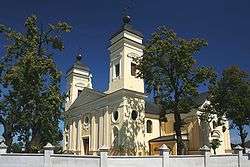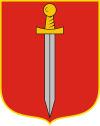Szczekociny
Szczekociny [ʂt͡ʂɛkɔˈt͡ɕinɨ] is a town on the Pilica river, in Silesian Voivodeship, Poland, with 3,612 inhabitants (2019). The Battle of Szczekociny was fought near the town on June 6, 1794 during the Kościuszko Uprising. Even though Szczekociny administratively belongs to Silesian Voivodeship, it is part of historic province of Lesser Poland. It was granted town rights in 1398, and lost them in 1870, on the decision of Russian authorities (see Congress Poland). Szczekociny once again became a town on Jan. 1, 1923. Since its foundation until 1795, Szczekociny belonged to Kraków Voivodeship. In the Second Polish Republic, it was part of Kielce Voivodeship, and since 1999, it has belonged to Silesian Voivodeship, despite the fact that it had never been part of Silesia.
Szczekociny | |
|---|---|
 Church of Saint Bartholomew | |
 Coat of arms | |
 Szczekociny | |
| Coordinates: 50°38′N 19°50′E | |
| Country | Poland |
| Voivodeship | Silesian |
| County | Zawiercie |
| Gmina | Szczekociny |
| Government | |
| • Mayor | Jacek Lipa |
| Area | |
| • Total | 17.98 km2 (6.94 sq mi) |
| Population (2019-06-30[1]) | |
| • Total | 3,612 |
| • Density | 200/km2 (520/sq mi) |
| Postal code | 42-445 |
| Area code(s) | (+48)34 |
| Car plates | SZA |
| Website | http://www.szczekociny.pl/ |
History
First mention of Szczekociny comes from 1307. At that time, the village belonged to the Odrowąż noble family (see Odrowąż coat of arms), County of Lelów, Kraków Voivodeship. In the late 14th century Szczekociny became the seat of the Odrowąż family, emerging as a local trade and craft center. In the 16th century, the town, together with other locations of Lesser Poland, enjoyed the period of prosperity known as the Polish Golden Age. In the mid-17th century, however, it was completely destroyed by the Swedes, during the Swedish invasion of Poland, and did not recover until the 18th century, when it belonged to the Dembiński family, whose efforts resulted in reconstruction of most buildings. The owners remodelled local parish church and built a palace, which still exists, and which in 1787 hosted King Stanisław August Poniatowski. After the Partitions of Poland, Szczekociny found itself in the Russian-controlled Congress Poland (since 1815).
In the 19th century Szczekociny changed hands several times, belonging to the families of Czacki, Lubieński and Halpert. In 1870 the Russians demoted it to the status of a village, and at that time, first Jews began to settle here. In the 1920s Szczekociny had over 6,000 inhabitants, the most in its history. World War II resulted in the death of 2,000 residents, including 90 percent of its Jewish residents, and the destruction of over 75% of the town. During the war Szczekociny was a major center of anti-German resistance. In the summer of 1944, as part of Operation Tempest, local Home Army units tried to capture Szczekociny, destroying bridges over the Pilica and the Zebrowka rivers.
Points of interest
- The Dembinski Palace (1770s), surrounded by a park,
- St. Bartholomew Parish Church (ca. 1680), remodelled in the 1780s by Urszula Dembinska
Jewish community of Szczekociny
In 1937, two years before the outbreak of the Second World War, there were 3,018 Jews in Szczekociny, which made up slightly more than 50% of the entire number of inhabitants. Pictures of the remains of the Jewish part can be viewed at Szczekociny – YouTube.[2] In 1942 according to the Nazi German plans for the Final Solution, 1,500 Jewish residents of Szczekociny were deported to the Treblinka death camp. Others were shot in Szczekociny or Sedziszow, where they were taken before their final deportation.[3]
Some 10% of the Jewish residents survived the genocide, such as Izik Mendel Bornstein.[4] Bornstein's son Yossi has been at the forefront of renegotiating the relationship with a renovation of the current cemetery and synagogue, under the now full support of the local mayor. Another witness and survivor is Wolf Zylbersztajn.[5] Additional Jewish survivor-story is told by Daniel Zylbersztajn.[6][7]
Train crash
On 3 March 2012 a train crash took place near Szczekociny, when two passenger trains collided head-on. 16 passengers were killed. The incident provoked condolences from the leaders of a number of European countries.
Notable people
- Dow Ber Meisels (1798–1870), Chief Rabbi of Kraków and Warsaw
- Władysław Strzemiński (1893–1952), painter
- Katarzyna Kobro (1898–1951), sculptor
- Leon Zelman (1928–2007), Polish-Austrian publicist
Twin towns – sister cities
See twin towns of Gmina Szczekociny.
References
- "Population. Size and structure and vital statistics in Poland by territorial divison in 2019. As of 30th June". stat.gov.pl. Statistics Poland. 2019-10-15. Retrieved 2020-03-21.
- שצ'קוצ'ין Szczekociny – YouTube.
- Megargee, Geoffrey (2012). Encyclopedia of Camps and Ghettos. Bloomington, Indiana: University of Indiana Press. p. Volume II 327-328. ISBN 978-0-253-35599-7.
- מלחמת המוסר והצדק התחילה (Morality and justice), Hebrew; from the Internet Archive
- Zylberstein / Silberstein, Jewish Shoa Survivor born in Sczekociny
- "Szczekociny, a small Polish town facing a difficult past," by Daniel Zylbersztajn
- Possibilities and impossibilities of being a neighbor
External links
| Wikimedia Commons has media related to Szczekociny. |
- Jewish Community in Szczekociny on Virtual Shtetl
- Szczekociny, Poland at JewishGen